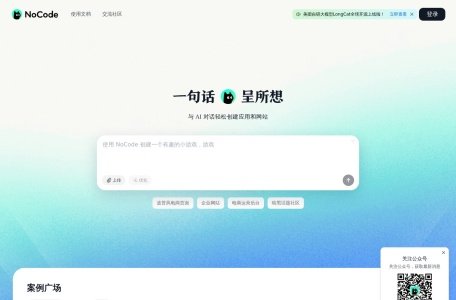
Still worried about finding programmers for digital needs? The emergence of NoCode (zero code) has completely reconstructed the logic of software development – through visual drag and drop, AI-assisted configuration, no need to write a line of code, non-technical personnel can also quickly build websites, office systems, business applications, so that ideas and needs directly to the ground. This article combines the latest industry trends and mainstream platforms in 2025, to dismantle the core value of NoCode, application scenarios and selection guidelines, and take you to unlock the new era of universal development.
NoCode core positioning: breaking the technical barriers of “universal development tools”.
NoCode’s core mission is to “make development accessible”, it is not eliminating the code, but the complex programming logic encapsulated into visual components, positioning can be summarized as “three types of users efficiency engine”:
- Non-technical staff (operation, product, administration): no need to learn programming language, through drag and drop, configuration can build the exclusive tool, to solve the “slow response to demand”, “dependent on the technical team” pain points;
- Small and medium-sized enterprises (SMEs): complete digital transformation in 1/10 of the cost and 1/5 of the time, and have customized systems for office automation, customer management, etc., without setting up a professional development team;
- Technical team: liberate the duplication of development work, focus on the core complex functions, so that IT resources can be focused on high-value innovation.
According to IDC’s “2024 Global Enterprise Digital Transformation White Paper”, the global zero-code platform market size exceeded $8.9 billion in 2024, a year-on-year growth of 34%, more than 60% of domestic SMEs will be “zero-code tool introduction” as a digital priority, NoCode has become the core of enterprise digital transformation. Infrastructure. Unlike LowCode, which focuses on “assisting developers to speed up”, NoCode is completely oriented to business people, truly realizing “everyone can develop”.
Second, the core features of the actual test: 5 highlights, reconstructing the development experience
1. AI-driven development: natural language becomes an application in a second
The core breakthrough of NoCode platform in 2025 is the deep integration of AI and development scenarios, which can generate applications in a single sentence without complex configuration:
- Conversational construction: Describe the requirements to the platform (e.g., “build an e-commerce order tracking system, including ordering, shipping, and after-sale status”), and the AI automatically generates forms, processes, and data associations, with real-time previews while chatting and making changes;
- Intelligent optimization: AI can identify business process bottlenecks and automatically recommend optimization solutions, such as adding a “timeout reminder” and “proxy approval” function to the approval process;
- Digital staff generation: no code to build industry-specific digital staff, such as AI sales consultants automatically integrate customer data to generate follow-up strategies, AI legal real-time review of contract risk points.
The conversational NoCode tool that will be launched in 2025 by Meituan will realize “cross-device synchronization of needs, one-click publishing and sharing”, making application development as simple as sending a circle of friends.
2. Drag-and-drop visualization construction: what you see is what you get
This is the basic core function of NoCode, and the threshold for testing is extremely low:
- Component splicing: the platform provides forms, processes, reports, charts and other massive prefabricated components, drag and drop to the canvas can be used, support for custom styles and logical associations;
- Process visualization: configure the approval and flow rules by connecting the lines, and support complex logic such as multi-conditional branching and timed triggering, without the need to understand the code logic;
- Real-time preview iteration: you can view the effect of the PC terminal and mobile terminal at any time during the building process, modification without restarting, accurate adjustment is more efficient.
3. Full-scene template ecology: 3 days to land digitalization
Mainstream NoCode platform has precipitated 200+ industries, 1000+ standardized templates, the actual test does not need to build from scratch:
- General scenarios: personnel attendance, customer management, inventory statistics, project collaboration, etc. out-of-the-box;
- Industry scenarios: manufacturing production work order system, order management system for e-commerce, government approval process system and other exclusive solutions;
- One-key reuse modification: the template supports on-demand adjustment of fields, processes, an automotive parts and components enterprises through the template to build a production management system, 3 days to complete the on-line.
4. Seamless ecological integration: breaking data silos
NoCode platform is not an information island, and it can be deeply linked with existing systems:
- Office ecosystem: deep integration with Nail, Enterprise WeChat and Flybook, supporting address book synchronization, message push and multi-end collaboration;
- Business systems: can be docked with ERP, CRM, OA and other existing systems to achieve data interoperability and sharing, such as zero-code form data is automatically synchronized to the enterprise data center;
- Third-party tools: support access to third-party services such as payment, SMS, AI models, etc., to expand the boundaries of application functions.
5. Security Compliance + Flexible Deployment: Enterprise-level Protection
For the core needs of enterprises, NoCode platform provides perfect security and deployment solutions:
- Data security: ISO27001 certified, supporting data encryption and fine-grained control of permissions, part of the platform is certified as a home-grown system and meets the requirements of Level 3 of the Equalization Guarantee;
- Flexible deployment: it supports cloud deployment (pay-as-you-go, elastic expansion) and private deployment (local storage, data isolation), adapting to sensitive scenarios such as government affairs and finance;
- Convenient operation and maintenance: the platform provides automatic backup, fault warning, performance monitoring and other functions, so that non-technical personnel can also complete daily operation and maintenance.
C. 2025 Mainstream NoCode Platform Inventory: Selection without stepping on pits
1. Light Stream AI+ NoCode Platform: Enterprise First Choice
- Core advantages: industry-leading AI capabilities, support for digital employee construction, 6 core engines to support group-level complex needs, 200+ industry solutions, outstanding localization adaptation and compliance;
- Typical customers: large enterprises such as Haier, Geely, China Telecom, etc., with 92 points of AI function user satisfaction;
- Applicable scenarios: large enterprises, complex business processes, government compliance scenarios.
2. Jandao Cloud: The First Choice for Lightweight Collaboration
- Core advantages: rich template ecology (1000+), mature process engine, deep integration with office ecosystem, support for multi-terminal real-time collaboration;
- Typical customers: Zhuzhou Institute of China Railway, China Postal Savings Bank, with an annual average of 910 million+ forms;
- Applicable scenarios: small and medium-sized enterprises, cross-departmental collaboration, basic office automation.
3. Cloud Forms: benchmark for enterprise-level system construction
- Core advantages: support ERP, WMS and other complex business systems, strong system integration capabilities, localized deployment to adapt to the manufacturing and financial industries.
- Typical Customers: Xuji Group, Dongxin Peace, a logistics enterprise uses it to build WMS system, and the picking error rate is reduced to below 0.03%;
- Applicable scenarios: manufacturing, logistics industry, core business system development.
4. Tritium Cloud: Nail ecological collaboration tool
- Core advantages: deep integration with Nail, no need to jump platform to develop, AI form generation function will compress the production time from hourly to minute level;
- Typical customers: small and medium-sized retail enterprises, government grass-roots units, a chain brand with which to build store inspection system, the problem rectification rate increased by 70%;
- Applicable scenarios: enterprises relying on the Nail ecosystem, lightweight inspection/approval needs.
Fourth, the typical application scenarios: covering the entire industry digitization needs
1. Enterprise office automation
The human resources department builds personnel recruitment, attendance clocking and performance evaluation systems, and the administrative department builds office supplies requisition and fixed assets management processes to automate low-value work. An enterprise builds an approval system through NoCode to save 1.207 million yuan in annual labor costs.
2. Production and Supply Chain Management
The manufacturing industry uses NoCode to build production work order, inventory management and quality inspection process systems, realizing real-time synchronization and traceability of production data; logistics enterprises build waybill tracking and warehouse management systems, reducing inventory turnover days by 42%.
3. Entrepreneurship and personal creative landing
Entrepreneurs do not need a technical team, 3 days to build product prototypes, user feedback forms, e-commerce independent station, rapid verification of market demand; individuals can make interest community management tools, personal knowledge base, so that creativity quickly landing.
4. Government and Public Services
Government departments build convenient approval systems, matters declaration platform, the waiting time for the public to do business from 3 days to 4 hours; schools to build student registration, performance statistics, home-school communication system, to enhance the efficiency of education services.
V. Core difference between NoCode and LowCode: how to choose?
| Comparison Dimension | NoCode (zero code) | LowCode |
|---|---|---|
| Core Users | Non-technical staff (operations, administration, business) | Professional Developers |
| Learning threshold | Extremely low (no programming foundation required) | Medium (basic programming knowledge required) |
| Development Speed | Very fast (5-10 times faster than traditional development) | Faster (2-5 times faster than traditional development) |
| Degree of customization | Limited (dependent on platform components) | Unlimited (can write custom code) |
| Applicable Scenarios | Office automation, standardized business systems | Complex customized systems, high concurrency applications |
| Maintenance Maintenance | Business team independent maintenance | Technical team maintenance |
Simply put, NoCode is “assembled furniture for ordinary people” and LowCode is “power tools for carpenters”, which need to be selected according to the user group and the complexity of the demand.
Precautions for use and selection guide
- Demand matching priority: standardized, high-frequency repetitive scenarios (such as approvals, forms) preferred NoCode; the need for deep customization, complex logic of the core business system, it is recommended to select the platform to support code expansion or LowCode.
- Three-dimensional selection framework: Examine “technology adaptability (AI capability, component richness), business scalability (upgrade support from department to group), security compliance (deployment mode, certification qualification)” to avoid selection bias resulting in less than 30% utilization rate;
- Cost control: Priority is given to platforms that are pay-as-you-go and support free trials, and enterprise-level customers can negotiate exclusive discounts to avoid high one-time investment;
- Avoid over-dependence: complex data processing, high concurrency scenarios need to be combined with professional systems, NoCode is more suitable as a “supplementary tool” rather than a “core replacement”.
Summarize: the era of universal development has come!
NoCode breaks the technical barriers through “AI-driven + visualization + full-scene adaptation”, so that digitalization no longer relies on professional development teams, and becomes a core tool for SMEs to reduce costs and increase efficiency, and for individuals to realize their creativity. 2025, with the continuous upgrading of AI capabilities and the continuous improvement of the ecology, NoCode will further penetrate into all industries. In 2025, with the continuous upgrading of AI capabilities and the continuous improvement of the ecosystem, NoCode will further penetrate into various industries, opening up a new pattern of “everyone is a developer”.
Whether enterprises want to rapidly promote digital transformation, or individuals want to realize the realization of creativity, NoCode can provide efficient, low-cost solutions. Now is the best time to get into the game, choose the appropriate platform, you can make the demand without waiting, and quickly come to fruition.
Relevant Navigation


BigModel

NewDMXAPI

Google AI Studio

PaddlePaddle AI Studio
NewInBev Cloud AI Arithmetic

NewDakou

NewWordware

